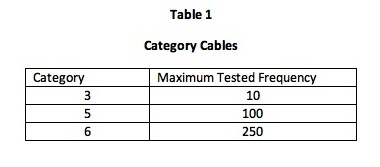Dear Professor Phil,I noticed that numerous new products boast about using category cabling. Some of these products transmit video, HDMI and other signals. While I’m familiar with Category 5 for LANs, I’ve always been curious about how these cables are qualified for each application. Also, how would I know which of my cables would fit a particular application?
-Bill, Boston, MA
- Bill,
- We’ll start with what determines the category of the cable. As a reminder, the term category is applied to twisted pairs cables. They always contain four pairs colored blue, orange, green and brown. The category a cable is classified in depends on how it behaves when certain frequencies are transmitted on the cable. If desirable characteristics are measured at both ends up to 100 Mhz, it would be category 5. If the good acceptable characteristics were measured up to 250 Mhz, the category would be 6. Table 1 lists the highest frequencies to which a cable must be certified in order to reach each category. Notice that Category 4 is no longer manufactured.
When the frequencies are sent down the cable, attributes such as attenuation, crosstalk, and delay are measured. If the cable doesn’t meet the target measurement values at any frequency on any pair, the cable fails to achieve that category.
Now, let’s look at why all of these measurement are made. On modern systems, the signal representing the data may be very complex. For example, in an encoding technique such as QAM-64 (quadrature amplitude modulation), each waveform is so complex that slight distortions of the signal would cause the receiver to misinterpret it. In my example, each waveform represent six bit. So, while a 100001 might have be sent, the receiver might interpret it as 101001.
Finally, I’ll address your question concerning certifying your own cables. You’ll need a cable tester capable of making the measurements. An example is the Fluke DTX CableAnalyzer Series or the Ideal 33-991 LanTEK II. The device sends a range of frequencies from 1 Mhz to the maximum desired level, such as 250 Mhz. The results are recorded and the instrument reports a pass or fail for the selected category.
Phil Hippensteel, PhD, is a regular columnist for AV Technology Magazine. He has spent more than 40 years in higher education and now teaches at Penn State Harrisburg.










